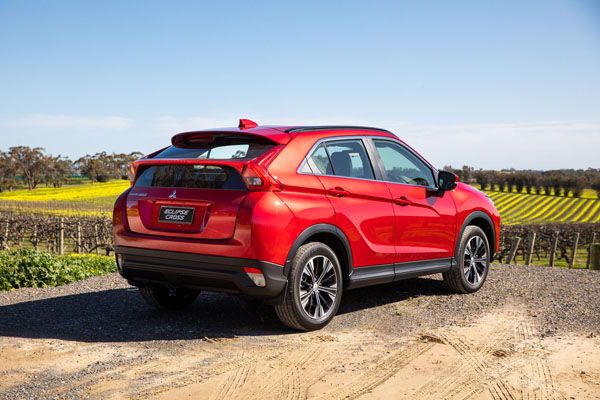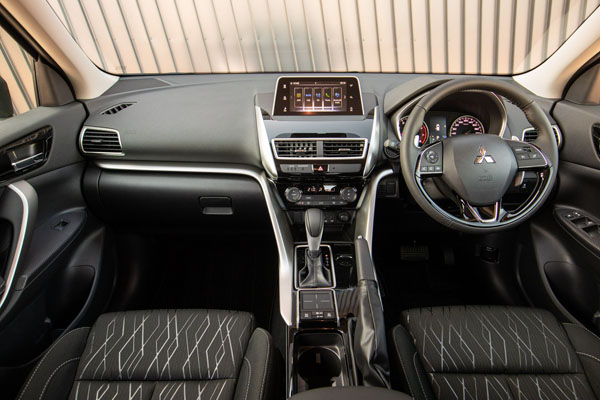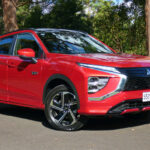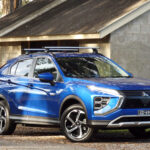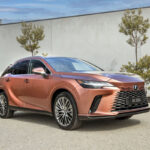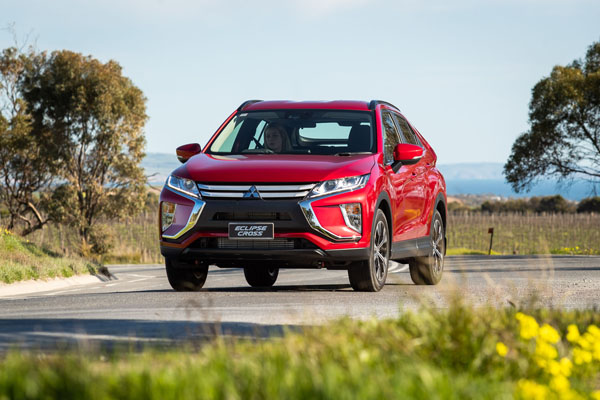 With the Eclipse Cross, a new spin has been given to the Mitsubishi sports utility vehicle orbit. Launched earlier this year, the all-new Eclipse Cross is the first of a new generation of Mitsubishi SUVs and joins the brand’s current lineup of the ASX, Outlander, Outlander PHEV hybrid, Pajero Sport and Pajero.
With the Eclipse Cross, a new spin has been given to the Mitsubishi sports utility vehicle orbit. Launched earlier this year, the all-new Eclipse Cross is the first of a new generation of Mitsubishi SUVs and joins the brand’s current lineup of the ASX, Outlander, Outlander PHEV hybrid, Pajero Sport and Pajero.
Initially, three variants were offered in Eclipse Cross LS and Exceed specification levels. Recently, an entry-level ES was added to the range, taking the line-up to four models.
Weighing in at a competitive price of $29,990, plus on-road costs, the ES features 18-inch alloy wheels, six-speaker Smartphone Link Display Audio, LED daytime running lights, reverse camera, front foglamps and forward collision mitigation.
The LS 2WD model ($31,990) is well equipped with the standard direct injection turbocharged engine, eight-speed continuously variable transmission, smart key and 7-inch SDA.
The Exceed adds dual-zone air-conditioning, leather interior, power and heated front seats, LED headlamps with auto levelling, double panoramic sunroof. The 2WD Exceed is priced at $36,000.
At $38,500 Mitsubishi’s flagship Eclipse Cross AWD Exceed comes standard with the same luxury appointments and comprehensive safety package as the 2WD Exceed with the addition of Mitsubishi’s Super All Wheel Control four-wheel drive system, all for $38,500. This was on our test menu.
STYLING
The exterior has the company’s Dynamic Shield exterior design theme, with foglamps and indicators being set lower within bumper recesses, and LED headlamps and daytime running lights incorporated in the main lighting assembly.
A bar and mesh upper grille, reinforced by roof lip spoiler and ‘venturi’ style lower bumper profile, add to the sporty look of the SUV.
Eclipse features double rear windows divided by high-mounted LED brake lights, giving a deeper, more expansive rear view than is normally found in SUVs of a coupe nature.
INTERIOR
Prestige is the byword here with quality cabin trim creating a stylish and crafted feel. Carbon and piano black accents adorn the instrument panel, steering wheel, centre console and door panels. A high finish silver trim surrounds the lower dash, centre console, front door armrests and air vents.
A 2670 mm wheelbase makes for a roomy ambience, added to by the twin bubble roof design ensuring generous headroom, even with the panoramic glass roof of the Exceed model.
Wide opening (75 degrees) rear doors are handy. Storage including a large double-compartment glovebox, centre console with sunglass tray and underfloor cargo box. A new ‘Sync’ function for the air-conditioning left and right temperature is a neat touch.
INFOTAINMENT
Mitsubishi’s Smartphone link Display Audio enables phone connectivity through Android Auto and Apple CarPlay, while selected apps, including navigation, stored on their smartphone, can be accessed through the colour touchscreen or via voice control.
The SDA, which is standard fitment to all Eclipse Cross models, also allows users to make calls or send SMS messages hands free and combined with a new touchpad controller on the centre console, allows for a more intuitive operation of Apple CarPlay. Android Auto users miss out here.
Digital Audio Broadcast (DAB+) is standard on all variants, along with the traditional AM / FM tuner.
ENGINES / TRANSMISSIONS
All versions of the Mitsubishi Eclipse Cross are powered by a direct injection turbocharged petrol engine developing 110 kW of power and 250 Nm of torque. It’s matched to an advanced new automatic transmission with Sport mode, manual override and paddle shifters.
The Eclipse Cross is available in two or four-wheel drive, the latter incorporating the latest generation of Mitsubishi’s Super All-wheel Control that offers a choice of three advanced drive modes – Auto, Snow and Gravel.
SAFETY
Comprehensive passive safety features are based on Mitsubishi’s RISE (Reinforced Impact Safety Evolution) impact safety body and seven airbags, including for driver and front passenger, side, curtain and driver’s knee positions.
Pedestrian protection measures are energy absorbing structures under the bonnet panel, cowl top and front bumper.
Active safety includes forward collision mitigation, lane departure warning, automatic high beam and hill start assist. Exceed models add blindspot warning, lane change assist, rear cross traffic alert, multi-around monitor, and adaptive cruise control.
Also included is ultrasonic miss-acceleration mitigation that reduces the chance and severity of hitting obstacles when the driver mistakenly presses the accelerator when stationary or at speeds of up to 10 km/h. Using ultrasonic sensors to detect obstructions in front of or behind the vehicle it regulates engine power while emitting an audible warning.
DRIVING
If silence is golden, the Eclipse Cross takes on a particularly auric character, with engine and road noise kept at bay from occupants in an efficiently-insulated cabin.
The new transmission follows suit, benefiting from the latest step logic technology to combine smoothness and responsiveness with fuel economy, the last ranging between seven and eight litres per hundred kilometres on a range of city and highway driving over the test period.
Snow and gravel were in short supply over this time, so the Super-All Wheel Drive system was strictly limited to Auto mode.
In spite of the onset of summery conditions, I had the opportunity to experience the seat heating, having caught the switch while dropping a set of keys into the adjacent cubby at the foot of the centre stack.
On switching off, the heat took some time to dissipate. I hesitate to say ‘no sweat’. Despite the heated moment, the leather upholstered seats were comfortably cool and at the rear a 60:40 split, with slide-and-recline adjustments gave occupants 200 mm of legroom, while also allowing occupants to get comfortable with eight 16 to 32-degree reclining steps.
The Smartphone Display Audio touch pad controller, situated on the centre console, took some getting used to, with the left hand not always up to the delicate touch and movement required. However, I’m sure it could be conquered with practice.
SUMMARY
The Eclipse Cross is a worthy addition to the Mitsubishi line-up of SUVs. With a price range of less than $10K over the four models, the well-specced upper-class variants, including the Exceed AWD, offer quite an attraction.
AT A GLANCE
MODEL LINE-UP
Eclipse Cross 1.5 ES 2WD (auto) $29,990
Eclipse Cross 1.5 LS 2WD (a) $31,990
Eclipse Cross 1.5 Exceed 2WD (a) $36,000
Eclipse Cross 1.5 Exceed AWD (a) $38,500
Note: These prices do not include government or dealer delivery charges. Contact your local Mitsubishi dealer for drive-away prices.
SPECIFICATIONS (Mitsubishi Eclipse Cross Exceed 1.5L 4cyl MIVEC direct-injection turbocharged petrol engine, CVT, AWD)
ENGINE:
Capacity: 1.499 litres
Configuration: Four cylinders inline
Maximum Power: 110 kW @ 5500 rpm
Maximum Torque: 250 Nm @ 2000-3500 rpm
Fuel Type: Petrol 91 RON
Combined Fuel Cycle (ADR 81/02): 7.7 L/100km
CO2 Emissions: 174 g/km
DRIVELINE: Continuously variable automatic transmission, Super-All Wheel Control
DIMENSIONS, WEIGHT AND CAPACITIES:
Length: 4405 mm
Wheelbase: 2670 mm
Width: 1805 mm
Height: 1685 mm
Turning Circle: 10.9 metres
Kerb mass: 1555 kg
Fuel Tank Capacity: 60 litres
BRAKES:
Front: Ventilated disc
Rear: Solid disc
STANDARD WARRANTY:
Five years / 100,000 km




